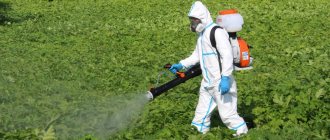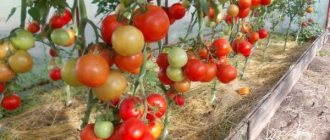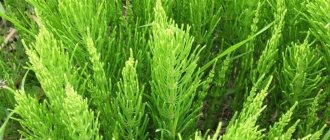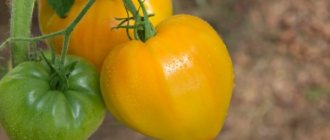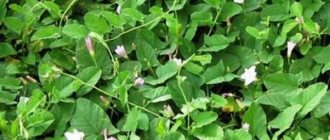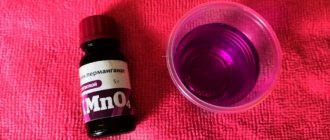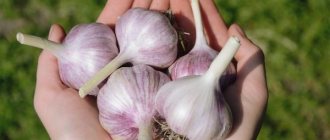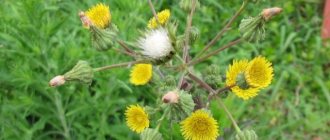Late blight is an insidious disease often found on tomatoes. In favorable years, the disease develops at lightning speed, capturing more and more new plantings of garden crops. Stopping the progress of late blight is not easy. The disease is easier to prevent by treating the soil before planting. Such treatments will protect not only tomatoes, but also other crops of the Solanaceae family.
Tillage in spring before planting and in autumn
- Spring tillage of soil against late blight is pre-planting, the main task of which is to destroy the dormant mycelium of the fungus - the causative agent of the disease. Processing times depend on the chosen method.
- Autumn tillage is carried out in case of infection of crops and to prepare the soil for winter. The soil on the site is cleared of plant debris and dug up to a depth of 30 cm with a layer turnover. In this case, the upper part of the soil turns down and is “embedded” into the ground. This way, most of the spores will end up on the soil surface.
Today, there are several methods to combat late blight in the soil. The choice of method depends on:
- intended purpose (for prevention or control);
- the extent of development and spread of the disease;
- personal preferences (some gardeners are categorically against chemistry, although in some cases its use is justified).
Treatments
If you have a very high pathogenic background on your site, like mine, then for the first year or two you will not be able to do without chemical fungicides; If there is no such disgrace, then you can try to do without them, just have them in stock just in case. I only used contact fungicides – Profit Gold and Hom. Regarding systemic drugs like Skor: they have a waiting period of at least 3 weeks, which does not suit me, because... My tomatoes ripen on the bushes and need to be picked periodically. Well, in general, there are big questions about the timing of the complete removal of these drugs from plant tissues.
Agrotechnical methods
These techniques will help reduce the likelihood of illness or avoid it altogether:
- Autumn and pre-sowing plowing . The vegetable garden is divided into ridges of 1.5-2 meters and plowed with a spade with the top layer of soil turned downwards. This is especially true in gardens with dense plantings, where it is humid and warm. In such conditions, the mycelium of the fungus develops faster. When digging the soil, all infected tops, tubers, and roots are destroyed.
- Crop rotation . Plants of the same family have the same diseases. By alternating crops, you can get rid of many diseases, including late blight. Tomatoes are planted in the garden after any Solanaceae at least 3-5 years later. During this period, the pathogen dies in the soil.
- Tilling the soil with boiling water in the fall . After harvesting, the soil is watered with boiling water. Oomycete spores die when exposed to high temperatures. This option is effective, but labor-intensive over large areas.
WHAT IS LATE BLOTH OF TOMATOES
Late blight is a disease of the nightshade family caused by the late blight fungus.
It parasitizes the green parts of plants and fruits, but also gets into the ground with raindrops. Phytophthora spores can survive in the soil for up to 5 years, withstanding severe frosts. Therefore, it is important to treat the beds after harvesting tomatoes, especially in a greenhouse, so as not to lose the tomato harvest next year. Late blight affects the leaves, stems and fruits of tomatoes
Before we consider the question of how to cure the soil from late blight, let's find out what the disease is? Late blight is a fungal infection that can affect a wide range of garden plants. Tomatoes and potatoes, as well as some nightshade plants, most often suffer from negative manifestations.
Symptoms of this disease appear on plants by mid-summer. During this period, the temperature even at night remains optimal for the development of the fungus. Humidity is maintained by rain or frequent watering of plants by careful gardeners.
The entire plant is exposed to late blight: first the leaves and stems dry out, and then the tomatoes themselves are affected. Most often, fruits that are still green or just beginning to ripen are affected.
With high humidity, infected areas of the plant begin to rot, and in dry times they dry out and break.
Sometimes you can see white and yellow hairs with heads or points at the ends. Most often they are clearly visible on tomato leaves. This is how late blight multiplies, and spores mature in the heads for further spread throughout the greenhouse to other plants. These areas should not be wiped; the spore capsules may rupture and small particles of spores may fly over long distances.
Folk remedies
These methods are very popular among gardeners because of their accessibility and harmlessness. True, you will have to wait a long time for the effect and the result may be dubious. Folk remedies are good for preventive purposes and will not harm crops:
- Garlic . A unique garden crop known for its bactericidal properties. Fights late blight, slugs, aphids, caterpillars and ants. An infusion of garlic bulbs is used to cultivate the soil before sowing seeds and soil for seedlings. Throughout the season, tomatoes are watered (no more than once every 2 weeks) to prevent disease and for treatment.
- Tillage of soil with dairy products under plants during the growing season.
The most commonly used are kefir or skim milk (whey). It is necessary to generously spray the soil under the plants and the plants themselves. Once in the soil, lactic acid bacteria create a microflora that is impenetrable to fungal spores. The disadvantage of this method is its fragility. After the first rain or watering, the treatment will have to be carried out again. Acceptable frequency of treatments: 1 time in 10 days. - Iodine and brilliant green. Popular broad-spectrum antiseptics. A few drops of antiseptic are dissolved in milk and the soil is treated before sowing, planting and during the growing season. This tool has a number of advantages:
- mineral nutrition for tomatoes;
- stopping the development of late blight or preventing it;
- protecting your garden from slugs.
- Infusion of rotted straw . The soil for tomatoes is watered before planting seedlings and after harvesting. The effect of the treatment is questionable and is more reminiscent of organic fertilizer.
- Wood ash . In the spring, sifted and dry ash is scattered on the soil and dug up. Afterwards, the tomatoes are watered generously. With frequent use, the acidity of the soil increases greatly. To regulate its acidity during autumn digging of the site, it is necessary to lim the soil by adding dolomite flour.
All folk methods are good because they are simultaneously a measure to combat late blight and organic plant nutrition. They can be used individually, or prepare a complex solution of several products.
Biological drugs
Unlike folk remedies, they have a visible effect in the early stages of late blight.
Their action is based on the influence of waste products of bacteria, fungi or microorganisms that make up the drug. The drugs are harmless to humans. They are used both as a preventive measure and to get rid of late blight in the soil. The following drugs are most effective :
- Baktofit and Trichodermin.
- Fitosporin -M.
- Planzir and Alirin B.
- Baikal EM (1; 5).
Remember
- Carry out prevention . Late blight on plants develops and spreads very quickly, and can deprive the harvest, so preventive treatment of plants is carried out.
- Remove tops . If the affected plant remains are not removed from the site, the infection will continue to actively destroy the plants in the new season. Burn infected stems and fruits.
- Use biological drugs . Give preference to effective and harmless products based on the work of beneficial bacteria.
Late blight is a dangerous enemy of the garden. Use any means to fight it, and your crop will not suffer from the infection.
How to disinfect soil with chemicals?
They are the most effective and fastest-acting method of protection. Many products are highly toxic and, if used incorrectly, can be dangerous to animals and humans. Hazard class 3 drugs are allowed for use on private farms. Chemicals are used at an advanced stage of the disease , or when it is very widespread.
When deciding how to treat the soil in spring or autumn, how to disinfect it, and ultimately cure it, you should pay attention to the following drugs:
- Quadris.
- Oksikhom.
- Copper sulfate.
- Copper oxide.
- Farmayod.
Phytophthora is able to quickly adapt to pesticides. Use a different type of drug for re-treatment.
Green manure against disease
This is a special group of plants grown to improve the structure of the soil, enrich it with nitrogen, inhibit the growth of weeds and combat late blight. Another name for green manure is green manure. To successfully combat late blight, the following sowing scheme is recommended:
- The first sowing is carried out immediately after harvesting.
- The second sowing is from mid-October until the first frost. In the spring, the seedlings will destroy the infection.
- For the third time, green manure is reseeded in the inter-row spaces of cultivated plants.
The main principle of action of green manure is that it releases substances that are destructive to fungal spores and inhibits the growth of weeds that carry the disease. The main green manures in the fight against late blight are :
- Mustard – white or yellow. It has the highest phytosanitary properties in comparison with other green manures.
- Phacelia.
- Oilseed radish or rapeseed.
To achieve the best result, it is recommended to sow all crops together - with a mixture of seeds.
Planting green fertilizer during the onset of infection will not give an effect, since they need to develop leaf mass (this will take 1.5-2 months).
Features of soil treatment in a greenhouse
High humidity in greenhouses and greenhouses in the absence of regular ventilation often causes the appearance and spread of the disease. Since late blight is a common occurrence in a greenhouse, it is recommended to change the soil annually, but such a measure is not always available. Among the agrotechnical techniques available:
- hot disinfection (2-4 weeks before planting seedlings, the soil should be watered with boiling water and covered with a film for deep steaming);
- acidification of alkaline soils by adding peat (phytophthora loves an alkaline reaction).
Therefore, regular application of disinfectants is sometimes the only option to combat late blight in the soil. The most effective in greenhouse conditions are biological and chemical means of protection :
- Trichodermin or Fitosporin for pre-planting soil treatment (the dry biological product is scattered on the surface of the ground three times: when digging for planting tomatoes, the second and third time - after 30 days).
- Copper-containing preparations - HOM, copper sulfate or Bordeaux mixture (their solution is spilled on the soil and frame elements of the greenhouse in spring or late autumn).
- Fungicide Ridomil Gold (the first treatment is carried out before the development of the disease, 1-2 weeks after planting the seedlings. The second – at the peak of a high risk of late blight or when the first signs of the disease are detected. It is important to complete the final treatment before the end of tomato flowering).
It is better not to close the greenhouse for the winter . Under the influence of low temperatures in the soil, most pathogens will die.
Causes of late blight
Fungal pathogens are active at high soil moisture. Phytophthora usually develops in the soil in the summer, when an abundance of dew falls on the ground in the morning. The air temperature should be within 15 oC. For this reason, the fungus most often spreads in August. After all, it is during this period that the air in the morning becomes cooler and there is an abundance of precipitation.
How to cure the soil from late blight in the fall? The difficulty of combating the disease lies in the lack of universal solutions. However, there are several methods that make it possible to eliminate the problem. We'll talk about the most effective methods below.
Agricultural technology experts note several favorable conditions for the development of active activity of the tomato late blight fungus:
- The growth of the disease occurs in wet, cold weather with daily temperature changes. In damp, rainy weather, parts of the plant rot; in dry, hot weather, they dry out and break. More often, late blight fungus begins to develop in August, when the air temperature drops and it rains.
- Phytophthora progresses in dense plantings with poor care. Weakened plants are more quickly affected by the disease.
- The proximity of tomato plantings to ridges of other nightshades is dangerous, especially if the latter are infected.
- The late blight fungus loves over-calmed soils with a high alkaline index.
- A lack of essential microelements, potassium, iodine, manganese, boron, increases the risk of late blight.
- Excessive application of nitrogen fertilizers to the soil, without observing the specified dosage, at the first drop in temperature gives signs of fungal infection in a pampered vegetable crop.
- The remains of infected plants left in the garden also become a source of disease.
Late blight affects all parts of the plant. In this case, late blight spores fall to the ground and are carried by gusts of wind. They penetrate deeply into the soil, tolerate frost well in winter, and in summer activate their vital activity, quickly attacking plantings. Competent tactics to combat the disease will prevent damage and death of the tomato crop. Let's consider how and with what to effectively cultivate the soil after late blight on tomatoes.
Previously, late blight was classified as a fungal disease, but recently scientists have begun to reconsider this point of view. Currently, the Oomycetes group has been isolated (separated) from the kingdom of Fungi, to which the pathogens of late blight belong.
We suggest you read: Why zucchini turn yellow and rot methods of control
Among nightshade crops, potatoes, tomatoes, bell peppers, eggplants and physalis most often become victims of late blight. Spores may be present in the surrounding soil and not manifest themselves until the right conditions arise (temperature 25 to 30 C, high humidity). Inactive spores, around which a drop of dew has condensed, can germinate in it in literally 1 hour.
In addition to heavy dew due to the high difference between night and day temperatures, late blight can also be provoked by heavy rains in late summer and early autumn. But a decrease in temperature to 10 C or an increase to 30 and above, accompanied by drought, reduces the activity of late blight to almost nothing.
Prevention
Most oomycete spores are found in the ground. In autumn and spring, the main preventive measures are digging up the soil, removing plant debris and disinfecting it. Let's consider what can be used for preventive soil disinfection. This is most often:
- a strong solution of potassium permanganate (it is a powerful antiseptic and, in combination with hot water, kills overwintering fungal spores);
- copper-containing preparations (only for early spring application during the first plowing of the land);
- biological product Fitosporin-M (the solution is prepared in water at a temperature of no more than 35 °C, so that diseased bacteria do not die. The drug is allowed to infuse for 1-2 hours).
Fungal spores reach plants with rising air currents from the heated soil. To prevent this, it is recommended to mulch the top layer of soil immediately after digging it in the spring.
Sequencing
Tillage after harvesting potatoes should be done in the following sequence:
- Collect tops and rotten tubers and burn.
- If the gardener wishes, dig up the soil a little or loosen it with a flat cutter.
- Pour hot water, solutions of copper sulfate or Bordeaux mixture into the growth areas of bushes affected by late blight. Regular boiling water, which is preferred by supporters of organic farming, is still better than poisoning the soil with copper salts, although it also kills beneficial microflora.
- A day after watering with boiling water or 7-10 days after treating the beds with copper sulfate, it is recommended to spill a solution of some biological product. If the weather is still warm, EM fertilizers are suitable. "Trichodermin" and "Trichofite" are incompatible with alkalizing fertilizers and are effective only for acidic soils. The universal and cheapest drug that can be used to cultivate the land in the fall after potato late blight is Fitosporin-M.
- In the spring, fertilize the soil and water again with the biological product. Apply organic and inorganic fertilizers as usual.
Advice from experienced gardeners
- Vladimir, Lipetsk region. “I use proven resistant tomato hybrids. I don’t resort to chemicals; I always sow mustard next to the tomatoes.”
- Oksana, Moscow region . “I grow tomatoes in a greenhouse and am not too lazy to change the soil. I replace the soil for planting every 2-3 years and compose it myself, always adding ash and Fitosporin-M.”
Only comprehensive measures will protect the garden from possible outbreaks of late blight. At the first symptoms of the disease, it is not advisable to completely abandon chemotherapy. Proper use of agrotechnical measures, biological protection agents, cultivation of green manure and crop rotation guarantee the health of tomatoes and other vegetable crops.
